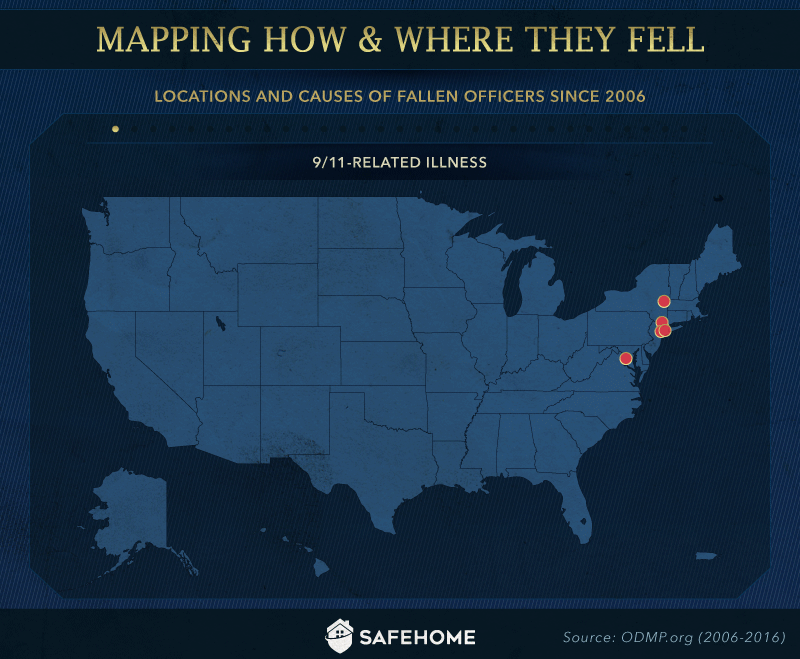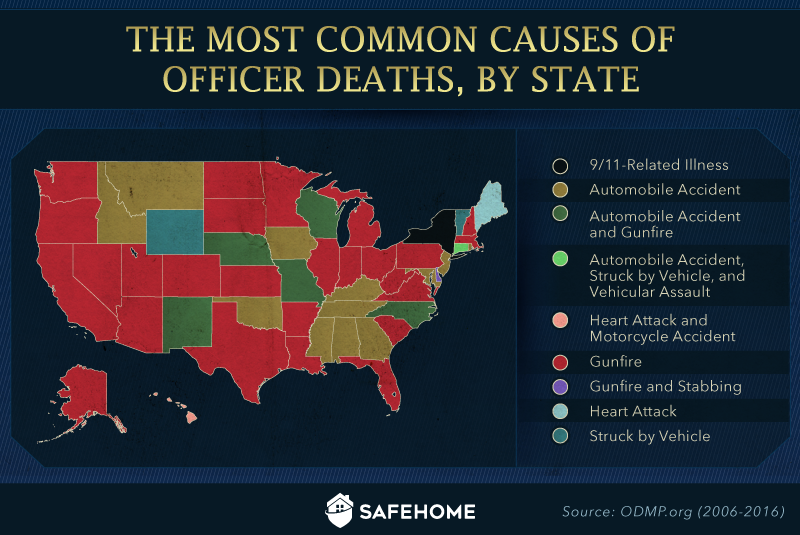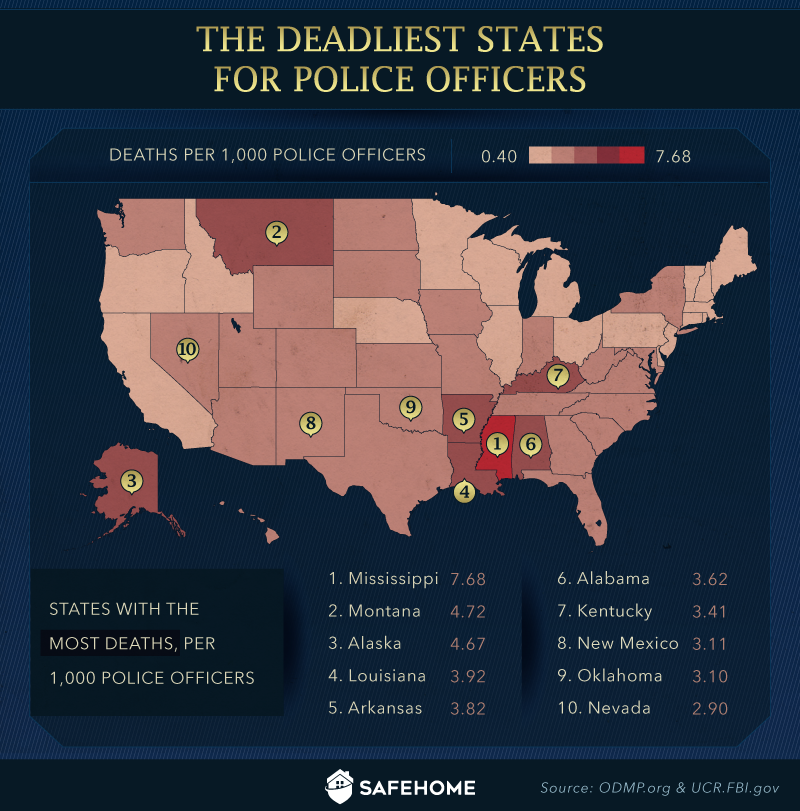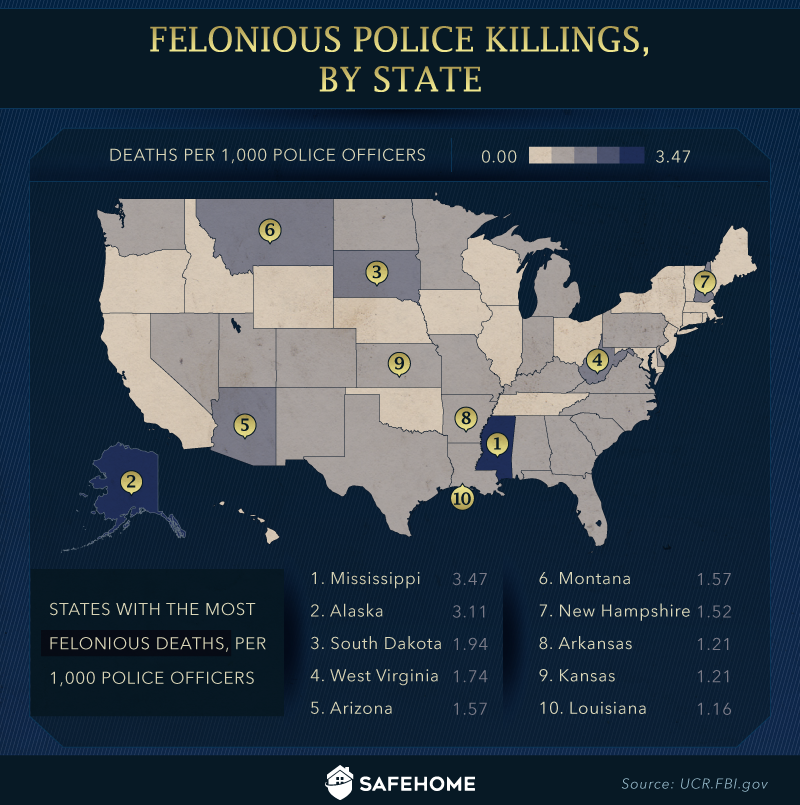In the Line of Duty
Since January 2018, an average of 144 police officers have been killed in the line of duty every year, according to ODMP.org data. Also, 25 K-9’s have perished each year while helping their officers serve. Compare that with 130 officer deaths and 27 K-9 deaths in the year 2017, and it becomes clear that the issue isn’t going away anytime soon.
The good news is that these figures are a significant improvement over the 101 murders recorded in 1978 or the 145 murders from gunfire alone in 1971. In fact, officer deaths while on the job have generally dropped since the ’80s, according to BBC News.
Of course, this is no consolation for the terrible individual losses of these families. Every loss is a tragedy. Although police officers are becoming statistically safer day-by-day, there are still dozens of deaths every year. We analyzed data from the Officer Down Memorial Page since 2006, as well as the FBI’s preliminary data, to see what these incidents have in common and where they are occurring most frequently.
The Causes and Locations of Officer Deaths
To better understand these incidents, we mapped the different locations of fallen officers in relation to the cause of death. There have been almost 2,000 police officer deaths since 2006, including over 200 K-9 fatalities. As you can see from the map above, there isn’t a single state that hasn’t lost one or more officers.
According to the FBI’s preliminary data, of the 41 felonious officer deaths in 2015, 19 of them happened in the Southern states. Accidental deaths were also higher in the South, with 29 in that region. Many of these deaths were due to gunfire according to ODMP.org, and most gunfire deaths were not accidental.
10 Years of Fallen Officers
We also mapped officer death locations from the past to help us better understand where police face the most danger, and how that danger has shifted (and decreased) over time.
This follows the larger trend of decreasing crime in the last 25 years across the U.S. Some experts credit economic improvements, the hiring of more police officers, and controversial theories linked to abortion. Whatever the reason for the decline of violent crimes, the drop in police fatalities is likely connected.
>> Also see: Police Employment Statistics
The Most Common Causes of Officer Fatalities

Data shows that the most common cause of officer deaths in the U.S. is, by far, gunfire. This occurs most often in states with high rates of gun ownership.
The second-highest number of fatalities, also by a large margin, were the result of automobile accidents. This may be because traffic accidents rose steeply in 2015 or because “the average Massachusetts State Police cruiser travels 22,500 miles a year, nearly double the typical mileage for U.S. drivers,” according to the Boston Globe. The newspaper didn’t share data on other states, but it’s safe to assume that a majority of police cruisers are driving more often than the average driver.
Heart attacks are the third-most-common cause of police deaths on the job, which might not be a surprise since heart disease is the leading cause of death in the United States overall.
Common Dangers for Officers, by State
When we look at the data on officer fatalities by state, some trends emerge. Gunfire is the largest danger in most states, including Texas, Alaska, California, and Florida – of which, Texas, Alaska, and Florida all have relatively high rates of gun ownership.
Auto accidents are the greatest danger for officers in a large number of states, as well – including Montana, Kentucky, and Georgia. Some of this may be because officers are on the road a lot. It also might be connected to the fact that states like Montana have relatively lenient laws on vehicle inspections, which means that more dangerous cars could be on the road.
In New York, 9/11-related illnesses have claimed the most lives in the recent past, and officers in Maine perish most due to a heart attack.
The Deadliest States for Officers
Data also suggests that some parts of the U.S. are much more dangerous for police officers than others. The most dangerous state is Mississippi, which was ranked as the No. 2 state in the nation for homicides in 2013. Montana, Alaska, Louisiana, and Arkansas also pose a significantly higher threat to officers.
High-Risk States for Officer Assault
While some officer deaths are purely accidental, many of the police deaths reported around the country are felonious losses. These killings are highest in Mississippi and Alaska – both of which are among the states with the highest gun ownership in the nation. South Dakota, West Virginia, and Arizona round out the top five. West Virginia and South Dakota have higher gun ownership rates as well.
Deadly Danger, by Rank
The risk of death is also significantly correlated with rank. Police officers are the most likely to be killed in the line of duty. This may be because officers are out of the office more than higher-ranking police, or it may be because of the types of calls delegated to officers. Deputies are the least likely to be killed while on the job.
Sheriffs are the second most likely to be killed while on the job, and K-9s are third. K-9s are a vital part of police departments; they help officers detect explosives and narcotics, as well as apprehend criminals and suspects who flee the scene on foot. Not to mention, they are comforting companions to the officers they work with.
The Reality of a Dangerous Job
Recent media coverage of shootings (both by and of police officers) has many convinced that there is an increased danger to both the public and police across the country. The reality for officers, however, is that their jobs are statistically much safer today than they were 10, 20, or 30 years ago.
Of course, the job is still dangerous, and fatalities are still a tragic and ever-present reality. Even one police death is one too many. But the strategies in place to reduce these numbers appear to be working, slowly decreasing fatality danger each year.
Methodology
We scraped the Officer Down Memorial Page for their list of officers and K-9s who have died in the line of duty since 2006. From this scrape, we were able to determine each employee’s rank, location of death, date of death, and cause of death. We obtained the felonious police killings data and the number of police officers in each state from the FBI. Total felonious killings accounted for the sum of all deaths from 2005 to 2014. Data was captured on August 4, 2016; data may have changed since then.
Fair Use
If you would like to honor these fallen officers by sharing our project, please be sure to link your readers back to this page.


.gif)
.png)



.png)